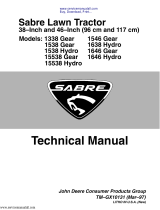Page is loading ...

Spring
Seats Retaining
Ring
Shaft
Springs
Housing
Sleeve
Bushing
Contact
Pins
Torque
Adj Bolts
H-TLC
Models 500 & 1000
Wave Washer
Actuating Disc Retaining Ring
Housing
Shaft
Rev1.01
Inch
Pounds
NM
Inch
Pounds
NM
Inch
Pounds
NM
500 4-60 0.5-6.8 40-125 4.5-14.1 100-150 11.3-16.9
1000 40-150 4.5-16.9 140-350 15.8-39.5 300-500 33.9-56.5
Blue Spring
Red Spring
Gold Spring
H-TLC
Model
Tools Required
• Flat-blade screwdriver
• Retaining ring pliers set
• Wrench set for torque adjustment
• SAE hex key allen wrench set
• Bench vise
All H-TLC models consist of two separate assemblies.
The drive Shaft assembly (internal portion) and the
Housing assembly (outer portion). In all H-TLC units these
two assemblies must be separated to gain access to the
springs.
Assembly—All Types (C, B, CD, BD)
Put a small amount of grease on the inside bottom of the
housing section. This increases contact pin life and
is a one-time-only procedure.
Follow Figure 1 to load spring seats, springs and contact
pins in Shaft section.
Slide Housing over Shaft assembly, making sure the Shaft
assembly's two internal set screws line up with access
holes in the Housing.
Model 500 units have a wear washer (not shown in Figure
1) which you slide on before the Shaft section retaining ring.
Install retaining ring by separating coils, inserting end of
ring into groove, then winding until the ring is completely
seated.
Note: You may have to slightly compress Shaft and
Housing sections to line up retaining ring grooves.
Install torque adjusting bolts nger-tight then further tighten
each equally to raise torque setting to desired level.
See Torque Adjustment Instructions.
Note: Reverse above procedure for disassembly.
Type CD and BD (with actuating disc)
Optional Actuating Disc Assembly (See below)
Place Actuating Disc over Shaft portion of H-TLC, then
install wave washer and retaining ring as shown. Install
retaining ring by separating coils, inserting end of ring into
groove, then winding until the ring is completely seated.
Note: Reverse above procedure for disassembly.
In applications where RPM exceeds 400 or where machine
drive might run unattended in an overload
condition, we recommend use of the
optional Actuating Disc assembly.
Upon overload, this mechanism
automatically moves axially to trigger
a customer-supplied limit switch. Limit
switch should be installed to trigger a
visible or audible alarm for the operator,
or to automatically shut down machine.
Torque Adjustment
Tighten torque adjusting bolts equally. Test the H-TLC as
you do this to determine when your desired disengagement
torque has been reached.
CAUTION: DO NOT ADJUST UNIT TO EXCEED TORQUE RATINGS
PUBLISHED IN BELOW TABLE BY OVERTIGHTENING! DO NOT
BOTTOM OUT SCREWS AS MAXIMUM TORQUE SETTING IS
REACHED BEFORE SCREWS BOTTOM OUT. RUNNING UNIT
WITH SCREWS BOTTOMED OUT COULD DAMAGE UNIT.
Torque Adjustment Range
CAUTION: SPRINGS CANNOT BE INTERCHANGED BETWEEN
H-TLC UNITS WITH DIFFERENT MODEL NUMBERS.
BECAUSE OF INERTIA AND/OR ENERGY IN POWER TRANSFER
EQUIPMENT, TORQUE LIMITERS WILL NOT PROTECT AGAINST
PERSONAL INJURY.
CAUTION: WEAR SAFETY GLASSES WHEN CHANGING SPRINGS.
If H-TLC disengages prematurely or if nuisance tripping is occuring, consider:
Adding an Actuating Disc, which can interface with a customer-supplied
limit switch which can be wired to shut-down the motor.
Soft-start the motor.
Increment to a larger torque setting by changing springs-see assembly
instructions.
H-TLC must be manually rotated or jogged into a full reset before
starting equipment.
/




